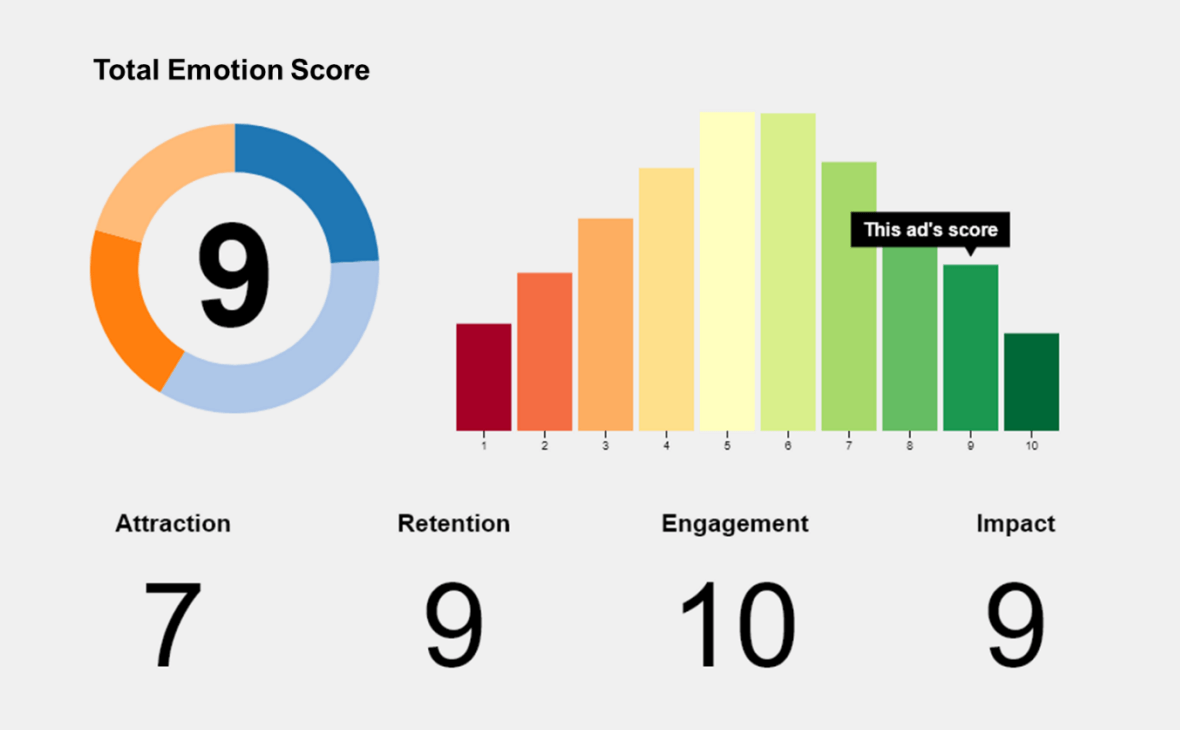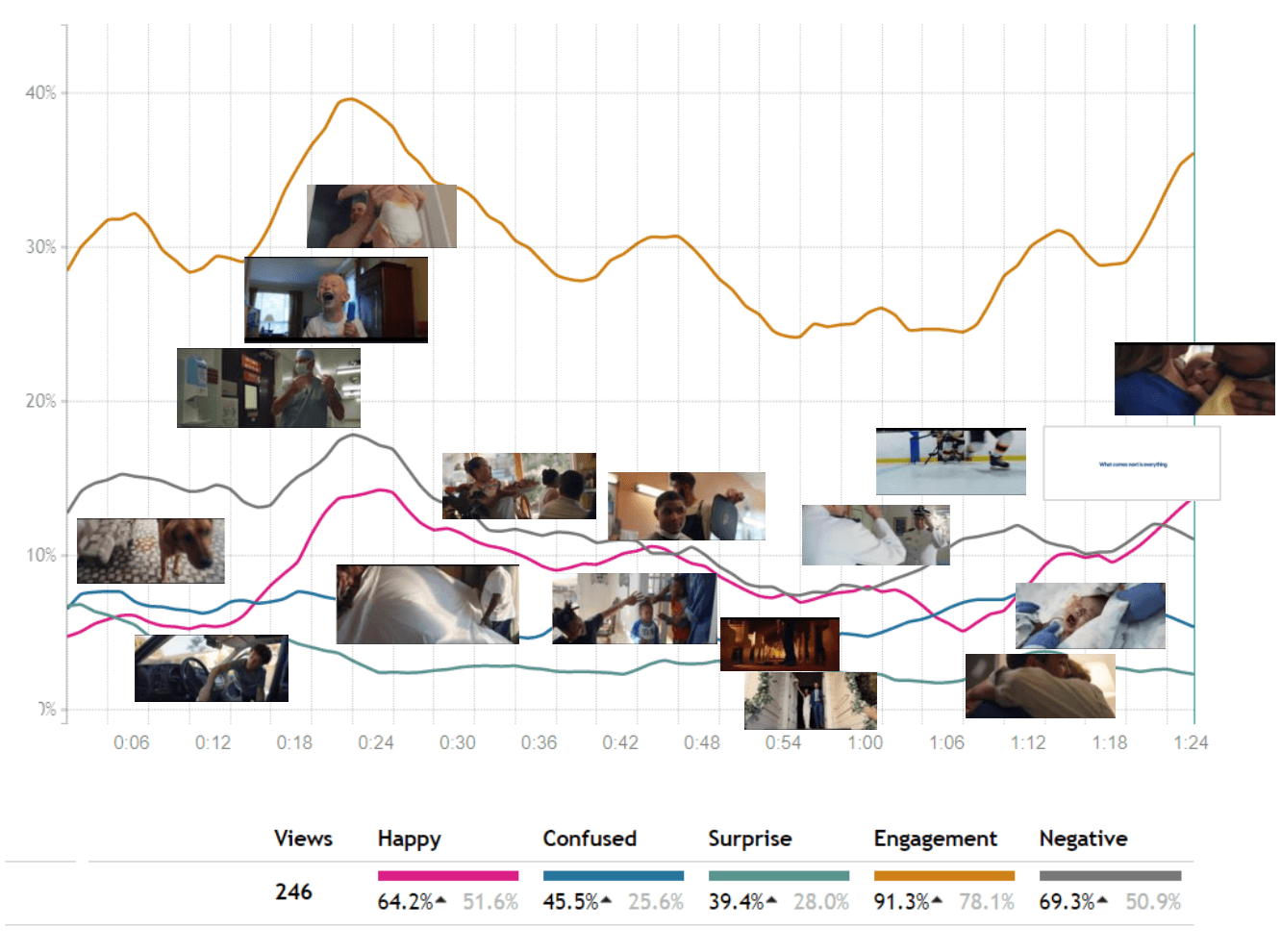MDRG tested two emotionally compelling ads, each achieving top-tier performance among thousands of tested spots—but for very different reasons. This case study breaks down how each ad succeeds—and where it stumbles—through detailed emotional and behavioral metrics, offering clear recommendations for optimizing future creative.
Both ads are emotionally engaging. Liquid Plmr Cracks’ overall score of 9 (on a 10-pt scale) puts it in the 93rd percentile among 13,000+ ads tested globally. Likewise, Clean Matters scores in the 85th percentile. However, each ad achieves its score in dramatically different ways. Let’s analyze each ad separately to understand strengths, weaknesses and specific execution recommendations.
Liquid Plmr Cracks – Total Emotion Score of 9
An ad’s overall score is comprised of 4 KPI’s:
- Attraction – Can you grab people’s attention? Measured by peak surprise during the early stages of the video.
- Retention – Can you keep people’s attention? Measured by peak happiness after the early stage of the video.
- Engagement – Can you build momentum during the ad? Measured by peak engagement (any emotion) at any point during the ad.
- Impact – Can you leave something behind? This metric is based on Daniel Kahneman's peak-toend rule, that the impression left by an ad is determined by the emotions evoked at its peak and at the end. Measured by taking peak happiness + end happiness / 2.

When we look at the second-by-second performance of the ad, we can see what’s driving our overall score. Attraction is somewhat compromised by steady, but not outstanding, surprise levels out of the gate (not shown). Engagement is high throughout, while Happiness peaks strongly at 0:15 and 0:43 leading to high Retention, Engagement and Impact scores. Below, we have plotted 5 key metrics – Overall Engagement, Happiness, Negativity, Confusion and Disgust. Engagement is the sum of any and all emotions exhibited, and includes happy, negative, confusion, disgust, surprise, sad and scared. Normative scores from over 13,000 ads tested are presented to the right of this ad’s performance.

This spot does a lot of things well, although the metrics clearly indicate viewer uneasiness with the scenes. While a good dose of negative tension often makes for a great ad, negativity ratings for this ad are significantly above norm – sometimes even surpassing happiness. Confusion levels and Disgust are also high. And lastly, Attention Volume (not shown) is low compared to the other Clorox ad tested, meaning that people were more prone to moving their face away from the screen instead of being drawn in by the ad. Verbatims back this up, as we see almost an equal number of people turned off by the ad than appreciate its cleverness and humor. The verbatim, “It was very weird to watch, but it caught my attention.” summed sentiment up nicely.
Of course, this assessment of the ad is incomplete, as core metrics of appeal, relevancy, salience, desire to watch again, etc. were not captured.
There are specific scenes that perform better than others, helping to drive happiness higher. At the beginning of the ad, the initial scene does a nice job, while the scene of the two older people in the pool also boosts enjoyment. Best of all, the ad does an excellent job of maintaining happiness levels through the product messaging and building them during the final scenes. The nighttime scene generates the highest engagement. This engagement is driven in part by high negativity and confusion (which is sometimes misreported when concentration levels are high), but also rebounding happiness levels. This ad, however, could easily be cut down to 30-seconds and perform just as well (if not better). There are certainly some scenes that underperform, such as the sidewalk scene, the bar, and the boxer – these could be eliminated to keep those pieces that drive higher Happiness. The sidewalk scene with two women walking in broad daylight also elicits peak Disgust, and could be the most “squeamish” scene in the entire ad. Other scenes are more neutral, and maintain momentum, but do not build it. Examples here include scenes in the flower shop, bowling alley, the firefighter and the painting studio.
The success of this ad is driven entirely by its engagement with women. They derive Happiness from watching it but are also somewhat turned off at the same time. Engagement, Happiness and Negativity among women are significantly higher than category norms, while men are about average.

Differences between age cohorts is also dramatically different. Those under 30 are engaged only at average levels – among this group, this ad neither overperforms nor underperforms. However, this ad hits home among those 30-49 and 50+, where engagement levels are both over 90% and statistically higher than the norm of 78.1%

“Clean Matters”
The Clorox spot is a tale of two ads – one that gets out of the gate strong and finishes well, and the one with depressed levels of Engagement and Happiness in the middle. Overall, however, it ranks in the 85th percentile overall, with a Total Emotion score of 8.

As can be seen below, Attraction is strong. Surprise levels start out very high and are significantly higher than norms. Surprise in the early stages of an ad are important to capture viewer attention.
Unlike “Liquid Plumr Cracks”, however, Happiness is slower to build. In fact, it isn’t until three strong scenes, one after the other, drive Happiness higher – the scenes of the doctor, laughing boy with a popsicle and the soiled baby diaper. Negativity is right there in lockstep with Happiness, and Engagement peaks at the 0:23 mark. From here, however, the ad loses momentum quickly until the very end of the spot. Scenes of clean bed sheets, laughing couple, and family meal do not elicit much Happiness. In fact, it’s only until we get some endearing shots of the kids measuring their height and another one getting a haircut does Happiness rebound slightly. Happiness continues to degrade quickly after this, paused only for a moment by the elderly man in the white military uniform. Happiness hits a low mark following quick scenes of a Zamboni, hockey players, ballet dancers and a Mom chasing her son with a wipe cloth. It is pretty clear at this point that viewers, without a narrative to follow, are simply reacting to each scene as it comes.

However, this ad redeems itself at the end. Sentimental scenes showing a crying woman getting a hug, and a newborn baby lift Happiness levels. Happiness continues to grow through the brand messaging to the final scene of a newborn, essentially ending with Engagement and Happiness similar to the aforementioned levels occurring at 0:23. According to behavioral economists, this strong ending Engagement is crucial to an ad’s ability to leave a lasting impression.
One has to wonder if the ad would have been more successful if the audience knew where it was headed early in the spot. Verbatims captured after watching the ad were littered with comments like this one, “There was so much going on, it was hard to know where the ad was leading to.”
That said, many more of the comments were positive, as once people found out the ad was sponsored by Clorox, the totality of the scenes presented made sense – “I thought that was a very engaging video. It reminded me of some of the most valued moments in life. I really enjoyed it and was able to see the connection between the video and Clorox.” Many also thought the commercial was heartfelt and moving, “I liked the video, it was emotional and beautiful.” though facial coding results generally show otherwise. In the end, respondents could simply be referencing memorable baby/child scenes, as these generally did well.
Facial coding results present a clear path to how this ad can be shortened without compromising any Engagement or Happiness. Many of the lesser-performing scenes could be shortened or removed altogether. Verbatims reflect this notion that the ad was considered too lengthy, “Disgusting and boring and WAY too long.” While we acknowledge that the spot can’t simply be a montage of cute babies, there are some parts of the ad, like the clean sheet, couple laughing, family dinner and hockey scenes, that do not move the needle.
Like “Liquid Plumr Cracks”, females react more strongly to this spot than males do across the three key metrics of Engagement, Happiness and Negativity. However, they are not solely responsible for this ad’s success. Men have significantly more Engagement than norms, just not at the level that women do.

Not surprisingly, the ad performs best among those age 30 and higher. While is generally what we saw with the Liquid Plumr ad, Engagement among those under 30 is significantly higher than norms as well. This suggests that this spot will have more balanced appeal across age cohorts.

Are you eager to stay ahead of the curve in your industry? Sign up for our monthly insights email and gain exclusive access to valuable market research, industry trends, and actionable recommendations delivered directly to your inbox.
Topics from this blog: CPG Market Research Brand